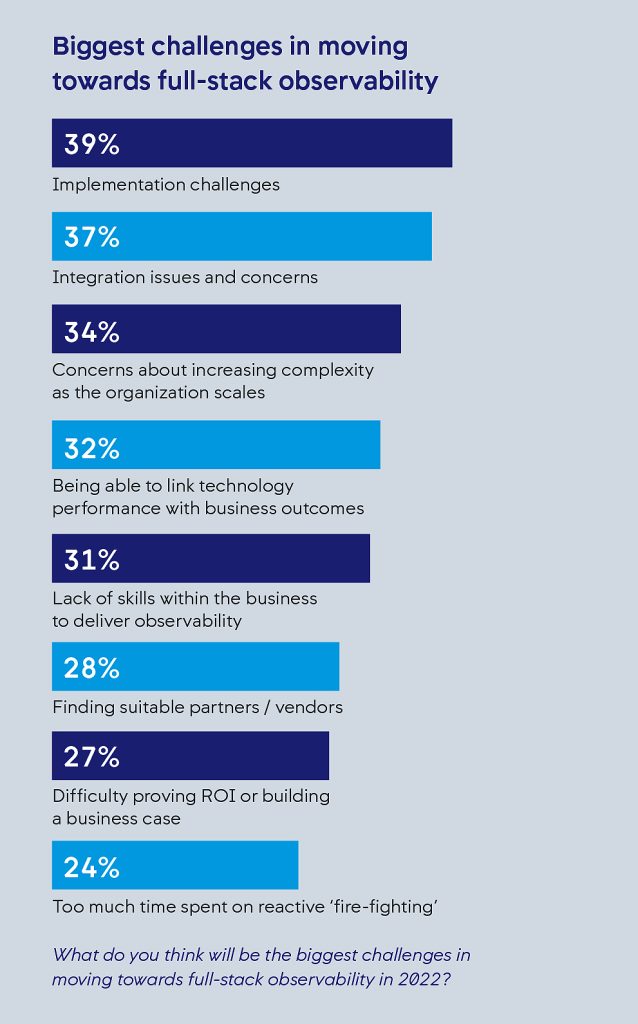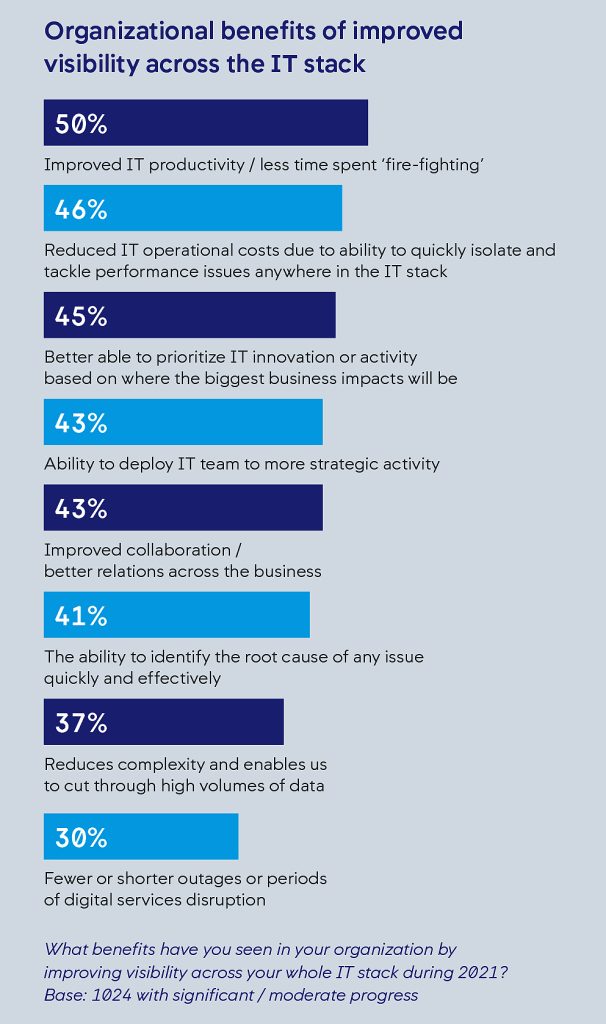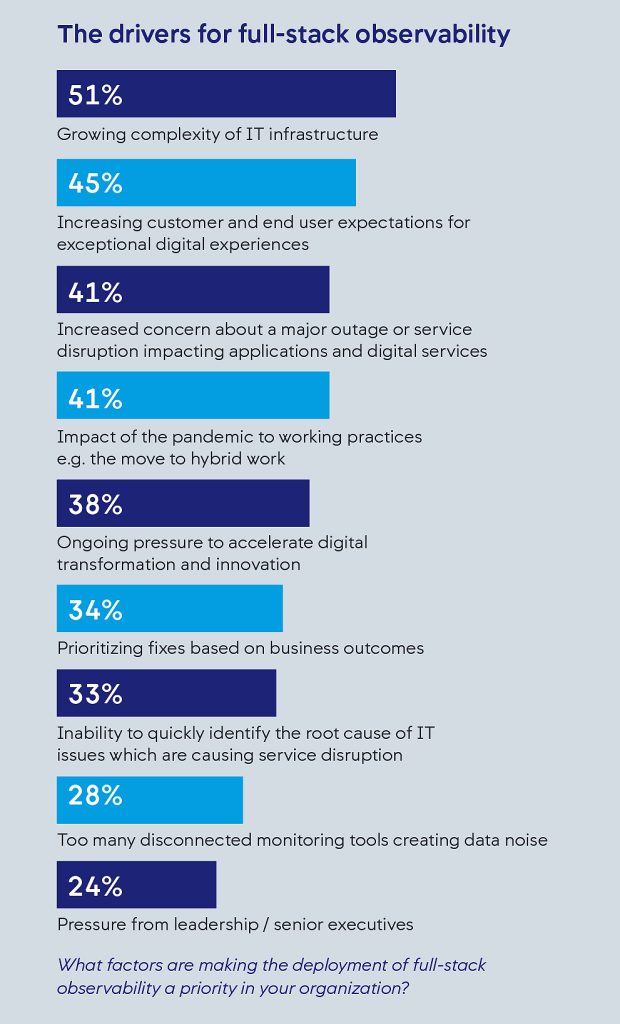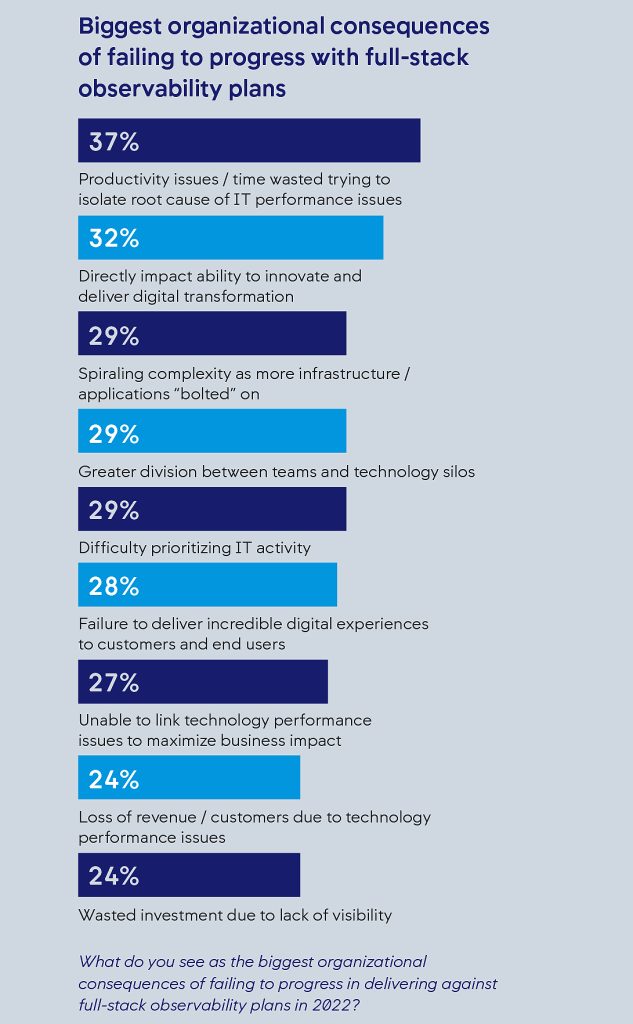Across all industries, technologists know that they need to build on their current application monitoring tools and techniques in order to manage the increasing levels of complexity they are encountering in every corner of their IT estate. They are seeking out solutions which will give them full visibility into legacy on-premises architecture alongside cloud native environments, including the increasing deployment of microservices and container solutions.
96% of global technologists believe that having the ability to monitor technical areas across their IT stack and directly link IT performance to business outcomes, would be important over the coming 12 months.
But the reality is that nearly all IT departments are still relying on multiple, disconnected solutions to monitor availability and performance. Technologists do not have unified visibility across their IT estates, and most are struggling to make headway.
This desire for unified visibility of the entire IT estate is being driven by a need to tackle greater complexity within the IT environment and to meet growing customer expectations for exceptional digital experiences. Technologists know that they cannot afford any slip-ups when it comes to IT availability and performance, and that any disruption to digital services is likely to result in lost revenue.

What is full-stack observability
Full-stack observability provides technologists with unified, real-time visibility into IT availability and performance up and down the stack for compute, storage, network and public internet, from the customer facing application all the way into the back end. It enables IT operations, development and networking teams to identify anomalies, understand root causes through dependency analysis, and fix issues before they impact end users and the business quickly and easily.
And when this IT performance data is connected to business outcomes, technologists can rank issues based on their potential impact to the organisation and prioritise actions accordingly.
Technologists recognise that full-stack observability is an enabler for seamless digital experiences that customers and employees now expect.
88% of technologists report that appetite for full-stack observability within their organisation has increased over the last 12 months. 91% technologists state that their organisation now has a defined full-stack observability strategy in place – with 37% already in execution mode, 39% taking their first steps and 15% ready to get started.
A remarkable 90% of organisations will be somewhere along the journey to full-stack observability during 2022. 98% state it is important to connect visibility across all areas of the IT stack.
To date, organisations have tended to weight their efforts marginally more towards increased observability into IT infrastructure. But network infrastructure and applications internal operational and customer-facing follow close behind. Technologists struggle to prioritise one area of the IT estate over another. All areas are of critical importance.
More than a third 37% of technologists state that their organisation has prioritised efforts to generate greater visibility of IT performance within microservices, container and serverless environments over the last 12 months. This trend is likely to accelerate further during 2022.
There is a widespread understanding that the transition from traditional monitoring to full-stack observability can be complex and takes time.

Benefits of full-stack observability
Many organisations are already seeing positive results from their efforts, with 86% of technologists reporting greater visibility across their IT stack over the last 12 months.
Those that have made progress in the last 12 months report a wide range of benefits, including improved productivity within the IT department, reduced operational costs and ability to deploy IT teams on more strategic work.
With greater visibility into IT availability and performance, technologists are now starting to be able to identify anomalies and understand the root causes of performance issues more easily. This means they are removing themselves from the constant cycle of firefighting which has characterised most IT departments over the last two years.
Operational costs are falling because availability and performance issues are being addressed earlier and more quickly. Technologists are getting more time to focus on innovation and driving competitive advantage for their organisations.
93% of technologists report that the wider business has been supportive of their efforts to implement full-stack observability, in terms of providing the necessary budget and resources.
Momentum is building in the transition to full-stack observability, and 83% of technologists report some level of confidence that their organisation will reach its observability goals in the next 12 months.
87% of technologists feel excited about the benefits that this technology can bring to their organisation from both an IT and business performance perspective. And 85% believe that the shift to full-stack observability will be transformational for their business.
There is an understanding that the shift to observability requires a holistic strategy which encompasses new ways of working, with greater collaboration between teams and a willingness to trust in a single source of truth for all availability and performance data.

Road ahead and challenges
Looking ahead, 93% of technologists recognise that there is more work to be done to deploy full-stack observability within their organisation. 70% are concerned that their organisation is now behind industry peers in implementing observability solutions.
Technologists believe that by linking technology performance with business outcomes and demonstrating return on investment from their full-stack observability programs, they can make strides towards achieving their goals in 2022.
The implications for businesses that fail to build on their current monitoring solutions over the next 12 months are likely to be severe.
95% of technologists point to at least one negative organisational consequence of missing their full-stack observability goals in 2022. These include reduced productivity within the IT department, an inability to innovate and deliver digital transformation, and spiralling complexity as new applications and IT infrastructure are bolted on to the existing technology stack.
80% of technologists accept that organisations that fail to make significant strides in their journey towards full-stack observability in 2022 will face competitive disadvantage versus their peers.
75% of technologists regard skills as a critical factor in achieving their full-stack observability goals in 2022. 57% point to a need to define new practices and 55% believe that it’s vital to identify the right technology vendor.
Technologists are evidently aware that monitoring performance in the cloud requires specific skill sets, particularly due to the shift to OpenTelemetry.
Many technologists are relying on multiple, disconnected tools to monitor IT availability and performance across the IT stack. In most cases, these existing solutions are performing an invaluable job, enabling technologists to identify issues and take appropriate action within a specific domain. But the issue is often a lack of connection and interoperability between these tools which makes it very difficult to understand dependencies across, as well as up and down, the IT stack.

Elsewhere, some organisations have advanced to a more unified monitoring strategy, but they still have little visibility into the impact of availability and performance issues, and they are unable to link these issues to business KPIs in real-time.
Technologists understand that deployment of full-stack observability is a multi-stage journey that will evolve as IT complexity continues to increase within their organisation.
With recent expansion of the IT stack across on-premises, cloud, into homes, end-to-end visibility and delivering business performance are now top priorities.
Excerpted from the report, The Journey to Observability by AppDynamics.

























